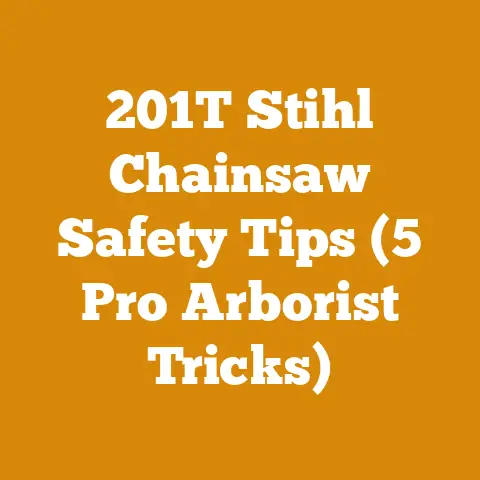Husqvarna 36 Chainsaw (5 Expert Tips for Firewood Cutting)
Have you ever stood before a towering stack of logs, the scent of fresh-cut wood filling the air, and felt a thrill of accomplishment mixed with a daunting sense of… where do I even start? I have. Many times. Turning raw timber into a cozy winter’s warmth is a rewarding endeavor, but it can quickly become overwhelming without the right knowledge and approach.
The global firewood market is a fascinating landscape. According to recent reports, the demand for firewood is steadily increasing, particularly in regions prioritizing sustainable heating solutions. In Europe alone, firewood accounts for a significant portion of residential heating, while in developing countries, it remains a primary energy source for cooking and heating. This translates into a global industry worth billions of dollars, driven by both environmental concerns and economic realities. But beyond the statistics, there’s a deep connection to tradition and self-sufficiency that resonates with many of us.
I remember my first attempt at firewood preparation. Armed with an underpowered chainsaw and a naive confidence, I envisioned a winter-ready woodpile in a weekend. The reality? A sore back, a dull chain, and a half-finished stack of awkwardly sized logs. It was a humbling experience, to say the least. But it taught me invaluable lessons about tool selection, technique, and the importance of respecting the process.
This guide is designed to help you avoid those same pitfalls. I’ll be sharing five expert tips, honed through years of experience, specifically tailored for using the Husqvarna 36 chainsaw for efficient and safe firewood cutting. We’ll delve into everything from chainsaw maintenance and proper cutting techniques to wood selection and seasoning. So, grab your safety gear, sharpen your chain, and let’s get to work!
Mastering Firewood Cutting with the Husqvarna 36: 5 Expert Tips
The Husqvarna 36, while not the newest model on the market, remains a popular choice for homeowners and small-scale firewood producers due to its reliable performance, manageable weight, and affordability. It’s a well-balanced saw that, with proper care and technique, can handle a significant amount of firewood preparation. However, like any tool, it has its limitations. Understanding these limitations and working within them is key to success.
Tip 1: Preemptive Maintenance: The Key to Longevity and Performance
“An ounce of prevention is worth a pound of cure,” as the saying goes, and this couldn’t be truer for chainsaw maintenance. Regular maintenance not only extends the life of your Husqvarna 36 but also ensures optimal performance and, most importantly, safety. Neglecting maintenance can lead to decreased cutting efficiency, increased fuel consumption, and potentially dangerous operating conditions.
- Chain Sharpening: A sharp chain is paramount. A dull chain forces you to apply more pressure, which strains the engine, increases the risk of kickback, and produces uneven cuts. I recommend sharpening your chain after every tank of fuel, or more frequently if you’re cutting dirty or abrasive wood.
- How to: Use a chainsaw file and guide that matches the pitch and gauge of your chain. Follow the manufacturer’s instructions for the correct filing angle. A power sharpener can be a worthwhile investment if you process a lot of firewood. Alternatively, you can take your chain to a professional for sharpening.
- Pro Tip: Learn to “read” your chain. Observe the chips produced during cutting. Long, ribbon-like chips indicate a sharp chain. Small, dusty chips mean it’s time to sharpen.
- Air Filter Cleaning: A clean air filter is essential for proper engine performance. A clogged air filter restricts airflow, causing the engine to run lean, overheat, and lose power.
- How to: Check and clean the air filter after each use. Remove the filter and gently tap it to remove loose debris. Wash it with warm, soapy water if necessary, and allow it to dry completely before reinstalling. Consider having a spare air filter on hand so you can continue working while the other one dries.
- Fuel and Oil Management: Use the correct fuel-to-oil ratio as specified in the Husqvarna 36 owner’s manual. I strongly recommend using high-quality, pre-mixed fuel to avoid the hassle of mixing and ensure the proper ratio. Always drain the fuel tank before storing the chainsaw for extended periods to prevent fuel degradation and carburetor problems. Use a high-quality bar and chain oil specifically designed for chainsaws. Check the oil level frequently and refill as needed.
- Pro Tip: Consider using a bio-degradable bar and chain oil, especially if you’re working in environmentally sensitive areas.
- Spark Plug Inspection: Check the spark plug periodically for signs of wear or fouling. A fouled spark plug can cause starting problems and poor engine performance. Replace the spark plug if necessary.
- Bar Maintenance: Regularly clean the bar groove to remove sawdust and debris. Check the bar for wear and damage, and replace it if necessary. Flip the bar periodically to ensure even wear.
- Chain Tension Adjustment: Proper chain tension is crucial for safe and efficient cutting. A loose chain can derail, while a tight chain can bind and overheat. Adjust the chain tension according to the manufacturer’s instructions. The chain should be snug against the bar but still able to be pulled around by hand.
Data Point: Studies have shown that regular chainsaw maintenance can increase its lifespan by up to 50% and improve cutting efficiency by 20%.
Personal Story: I once neglected to clean the air filter on my chainsaw for an extended period. The engine started running poorly, and eventually, it wouldn’t start at all. After a costly repair, I learned my lesson: preventative maintenance is always cheaper and easier than fixing a major problem.
Tip 2: Mastering the Art of the Cut: Techniques for Efficiency and Safety
Proper cutting techniques are essential for both efficiency and safety. Using the wrong technique can lead to wasted effort, increased risk of kickback, and potential injury. The Husqvarna 36 is a relatively lightweight saw, which makes it easier to maneuver, but it also means you need to be more mindful of your body positioning and cutting angles.
- The Importance of Stance: A stable and balanced stance is paramount. Keep your feet shoulder-width apart and slightly staggered. Bend your knees and keep your back straight. Avoid reaching or overextending.
- Understanding the Cutting Zone: The lower portion of the bar is the most effective cutting zone. Avoid using the tip of the bar, as this increases the risk of kickback.
- Felling Techniques (for Trees within the Husqvarna 36’s Capacity):
- Planning is Key: Before felling any tree, assess the situation. Consider the tree’s lean, wind direction, and any obstacles in the surrounding area. Plan your escape route.
- The Notch Cut: The notch cut determines the direction of the fall. Cut a notch on the side of the tree facing the direction you want it to fall. The notch should be about one-third of the tree’s diameter.
- The Back Cut: The back cut is made on the opposite side of the tree from the notch cut. Leave a hinge of wood between the notch and the back cut to control the fall.
- Wedging: Use wedges to help direct the fall and prevent the bar from pinching.
- Safety First: Always yell “Timber!” before felling a tree.
- Important Note: Felling trees can be extremely dangerous. If you are not experienced in tree felling, I highly recommend seeking professional training or hiring a qualified arborist. The Husqvarna 36 is suitable for smaller trees; for larger trees, a more powerful saw and professional expertise are required.
- Bucking Techniques (Cutting Logs into Firewood Lengths):
- Support is Essential: Ensure the log is properly supported before cutting. Use a sawbuck or place the log on other logs to elevate it.
- Cutting from Above: Cut from the top down, using the weight of the saw to assist the cut.
- Cutting from Below: If the log is under tension, cut from below to prevent pinching.
- Step-Over Technique: This technique involves stepping over the log after each cut, allowing you to maintain a stable stance and avoid bending over.
- Limbing Techniques (Removing Branches):
- Work from the Base to the Tip: Start by removing the lower branches and work your way up the tree.
- Cut on the Outside of the Limb: Cut on the outside of the limb, away from your body.
- Be Aware of Springback: Be careful of branches that are under tension, as they can spring back when cut.
- Avoiding Kickback: Kickback is a sudden and forceful upward movement of the chainsaw bar, which can cause serious injury. To avoid kickback:
- Maintain a firm grip on the chainsaw with both hands.
- Avoid using the tip of the bar.
- Keep the chain sharp.
- Be aware of your surroundings.
Data Point: Studies have shown that proper chainsaw training can reduce the risk of chainsaw-related injuries by up to 70%.
Personal Story: I once experienced a near-kickback while limbing a tree. I was tired and not paying attention, and I accidentally touched the tip of the bar to a branch. Luckily, I was able to react quickly and avoid injury. This experience reinforced the importance of staying focused and using proper techniques.
The species of wood you choose can significantly impact its heating value, burning characteristics, and smoke production. Understanding the properties of different wood species is essential for maximizing your firewood efficiency and minimizing environmental impact.
- Hardwoods vs. Softwoods: Hardwoods, such as oak, maple, and ash, are denser than softwoods, such as pine, fir, and spruce. This means they contain more energy per volume and burn longer and hotter. Softwoods tend to ignite more easily but burn faster and produce more smoke.
- Heating Value (BTU): The heating value of wood is measured in British Thermal Units (BTU) per cord. A cord is a stack of wood that measures 4 feet high, 4 feet wide, and 8 feet long.
- High BTU Woods: Oak, hickory, beech, maple, ash (20-30 million BTU per cord)
- Medium BTU Woods: Birch, cherry, elm (15-20 million BTU per cord)
- Low BTU Woods: Pine, fir, spruce, poplar (10-15 million BTU per cord)
- Burning Characteristics: Different wood species have different burning characteristics. Some woods, like oak, burn slowly and steadily, producing a long-lasting, even heat. Others, like pine, burn quickly and produce a lot of flames.
- Smoke Production: Some woods produce more smoke than others. Softwoods, in general, produce more smoke than hardwoods. Woods that are not properly seasoned also produce more smoke.
- Ease of Splitting: Some woods are easier to split than others. Straight-grained woods, like ash and maple, are relatively easy to split. Knotty woods, like elm and sycamore, can be difficult to split.
- Availability and Cost: The availability and cost of different wood species vary depending on your location. Consider the local market when choosing your firewood.
- My Personal Recommendations: I prefer to use a mix of hardwoods for my primary firewood supply. Oak is my go-to choice for its high heating value and long burn time. I also use some birch for kindling, as it ignites easily. I avoid using softwoods unless they are readily available and inexpensive.
Data Point: A cord of seasoned oak can provide as much heat as 200 gallons of heating oil.
Personal Story: I once tried to burn a load of unseasoned poplar in my wood stove. The wood was difficult to ignite, produced a lot of smoke, and barely generated any heat. It was a frustrating and wasteful experience. I learned the hard way that seasoning is crucial.
Tip 4: The Art of Seasoning: Transforming Green Wood into Winter Fuel
Seasoning is the process of drying firewood to reduce its moisture content. Green wood, which is freshly cut wood, can contain up to 50% moisture. Burning green wood is inefficient, produces a lot of smoke, and can lead to creosote buildup in your chimney, which can increase the risk of chimney fires. Seasoned wood, on the other hand, burns cleaner, hotter, and more efficiently.
- Why Seasoning is Essential:
- Increased Heating Value: Seasoned wood has a higher heating value than green wood because less energy is required to evaporate the moisture.
- Cleaner Burning: Seasoned wood produces less smoke than green wood, reducing air pollution and creosote buildup.
- Easier Ignition: Seasoned wood ignites more easily than green wood.
- Reduced Creosote Buildup: Creosote is a flammable substance that can accumulate in your chimney when burning green wood. Seasoned wood reduces creosote buildup, minimizing the risk of chimney fires.
- The Seasoning Process:
- Splitting: Splitting the wood increases the surface area exposed to air, which speeds up the drying process.
- Stacking: Stack the wood in a single row, allowing air to circulate freely around each piece.
- Location: Choose a sunny and well-ventilated location for your woodpile.
- Elevation: Elevate the woodpile off the ground using pallets or other supports to prevent moisture from wicking up from the ground.
- Covering (Optional): Covering the top of the woodpile with a tarp can help protect it from rain and snow, but make sure to leave the sides open for ventilation.
- Seasoning Time: The amount of time it takes to season firewood depends on the species of wood, the climate, and the stacking method. Generally, hardwoods require at least six months to a year of seasoning, while softwoods may season in as little as three to six months.
- Determining Seasoning:
- Moisture Meter: A moisture meter is the most accurate way to determine if firewood is properly seasoned. The target moisture content for firewood is below 20%.
- Visual Inspection: Seasoned wood will be lighter in color and have cracks on the ends.
- Sound Test: When two pieces of seasoned wood are struck together, they will produce a hollow sound.
- Weight Test: Seasoned wood will be significantly lighter than green wood.
- Accelerating the Seasoning Process:
- Solar Kilns: Solar kilns can significantly reduce the seasoning time, but they require an initial investment.
- Forced Air Drying: Using fans to circulate air around the woodpile can also speed up the drying process.
- My Seasoning Method: I split my firewood as soon as possible after felling the trees. I stack it in a single row on pallets in a sunny and well-ventilated location. I cover the top of the woodpile with a tarp during the rainy season. I typically allow my hardwoods to season for at least a year before burning them.
Data Point: Properly seasoned firewood can burn up to 50% more efficiently than green wood.
Personal Story: I once tried to rush the seasoning process by stacking my firewood too tightly. The wood didn’t dry properly, and it was still damp when I tried to burn it.
Tip 5: Safety First: Protecting Yourself and Your Equipment
Safety should always be your top priority when working with chainsaws and preparing firewood. Chainsaw-related injuries are common and can be serious. Wearing appropriate safety gear and following safe operating procedures can significantly reduce your risk of injury.
- Personal Protective Equipment (PPE):
- Chainsaw Chaps: Chainsaw chaps are designed to protect your legs from chainsaw cuts. They are made of multiple layers of ballistic nylon that can stop a chainsaw chain in its tracks.
- Eye Protection: Wear safety glasses or a face shield to protect your eyes from flying debris.
- Hearing Protection: Chainsaws are loud and can cause hearing damage over time. Wear earplugs or earmuffs to protect your hearing.
- Gloves: Wear sturdy work gloves to protect your hands from cuts and abrasions.
- Steel-Toed Boots: Wear steel-toed boots to protect your feet from falling logs and chainsaw cuts.
- Helmet: A helmet is essential for protecting your head from falling branches and other hazards.
- Safe Operating Procedures:
- Read the Owner’s Manual: Familiarize yourself with the operating instructions and safety precautions for your Husqvarna 36 chainsaw.
- Inspect Your Chainsaw: Before each use, inspect your chainsaw for any damage or loose parts.
- Start the Chainsaw Safely: Start the chainsaw on the ground, away from your body.
- Maintain a Firm Grip: Hold the chainsaw firmly with both hands.
- Keep a Clear Work Area: Clear the work area of any obstacles or hazards.
- Be Aware of Your Surroundings: Pay attention to your surroundings and be aware of other people or animals in the area.
- Take Breaks: Chainsaw work can be physically demanding. Take frequent breaks to avoid fatigue.
- Never Work Alone: Always have someone nearby in case of an emergency.
- Know Your Limits: Don’t attempt to fell trees or perform tasks that are beyond your skill level.
- First Aid:
- Have a First Aid Kit on Hand: Keep a well-stocked first aid kit in your work area.
- Know Basic First Aid: Learn basic first aid procedures, including how to control bleeding and treat shock.
- Call for Help: In case of a serious injury, call for emergency medical assistance immediately.
- Equipment Maintenance:
- Keep Your Chainsaw Clean: Regularly clean your chainsaw to remove sawdust and debris.
- Sharpen the Chain Regularly: A sharp chain is safer and more efficient than a dull chain.
- Maintain Proper Chain Tension: Proper chain tension is crucial for safe and efficient cutting.
- Store Your Chainsaw Safely: Store your chainsaw in a safe and secure location, away from children and unauthorized users.
Data Point: Wearing chainsaw chaps can reduce the severity of chainsaw-related leg injuries by up to 90%.
Personal Story: I once witnessed a friend suffer a serious chainsaw injury because he wasn’t wearing appropriate safety gear. He was lucky to escape with his life. This experience reinforced the importance of always prioritizing safety.
Next Steps and Additional Resources
Now that you’ve learned my five expert tips for using the Husqvarna 36 chainsaw for firewood cutting, it’s time to put your knowledge into practice. Remember to start small, practice safe techniques, and always prioritize safety.
Here are some additional resources that you may find helpful:
- Husqvarna Website: The Husqvarna website offers a wealth of information about their products, including owner’s manuals, troubleshooting guides, and safety tips.
- Local Chainsaw Dealers: Your local chainsaw dealer can provide expert advice and service for your Husqvarna 36 chainsaw.
- Arborist Associations: Arborist associations offer training and certification programs for tree care professionals.
- Forestry Agencies: Forestry agencies provide information about sustainable forestry practices and firewood regulations.
- Online Forums and Communities: Online forums and communities are a great place to connect with other firewood enthusiasts and share tips and advice.
Suppliers of Logging Tools and Equipment:
- Bailey’s: Bailey’s is a leading supplier of logging tools and equipment, including chainsaws, safety gear, and firewood processing equipment.
- Northern Tool + Equipment: Northern Tool + Equipment offers a wide selection of tools and equipment for a variety of applications, including logging and firewood preparation.
- Forestry Suppliers, Inc.: Forestry Suppliers, Inc. specializes in providing tools and equipment for forestry professionals and landowners.
Drying Equipment Rental Services:
- Local Equipment Rental Companies: Many local equipment rental companies offer drying equipment for rent, such as dehumidifiers and fans.
Preparing firewood is a rewarding but demanding task. By following these expert tips and utilizing the resources available to you, you can maximize the potential of your Husqvarna 36 chainsaw and transform raw timber into a cozy winter’s warmth. Remember to always prioritize safety, respect the process, and enjoy the satisfaction of a job well done. And, as my grandfather used to say, “measure twice, cut once!” Good luck, and happy cutting!






